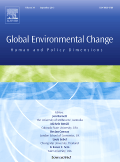
L’article « Greenhouse gas mitigation in Chinese agriculture: Distinguishing technical and economic potentials » de Wen Wang, Frank Koslowski, Dali Rani Nayak, Pete Smith, Eli Saetnan, Xiaotang Ju, Liping Guo, Guodong Han, Christian de Perthuis, Erda Lin, Dominic Moran, est publié dans la revue Global Environmental Change.
Abstract :
China is now the world’s biggest emitter of greenhouse gases with 7467 million tons (Mt) carbon dioxide equivalent (CO2e) in 2005, with agriculture accounting for 11% of this total. As elsewhere, agricultural emissions mitigation policy in China faces a range of challenges due to the biophysical complexity, the heterogeneity of farming systems, and social-economic barriers. Existing research has contributed to improving our understanding of the technical potential of mitigation measures in this sector (i.e. what works). But for policy purposes it is important to convert these measures into a feasible economic potential, which provides a perspective on whether agricultural emissions reduction measures are low cost relative to mitigation measures and overall potential offered by other sectors of the economy. We develop a bottom-up marginal abatement cost curve (MACC) representing the cost of mitigation measures applicable in addition to business-as-usual agricultural practices. The MACC demonstrates that while the sector can offer a maximum technical mitigation potential of 402 MtCO2e in 2020, of which a reduction of 135 MtCO2e is potentially available at zero or negative cost (i.e. a cost saving), and 176 MtCO2e (approximately 44% of the total) can be abated at a cost below a threshold carbon price of ¥ 100 (approximately €12) per tCO2e. Our findings highlight cost-effectiveness of nitrogen fertilizer and manure best management practices, and animal breeding practices. We outline the assumptions underlying MACC construction and discuss some scientific, socioeconomic and institutional barriers to realizing the indicated levels of mitigation.
L’article est disponible sur le site de Science Direct
